Skat
(see
first installment)
Although
I'm close to completing the hull on my as-yet unnamed Skat,
a 12' catboat designed by Jim Michalak, I've been a bit sidetracked
from hull work. I've done some work on the mast, started a pair
of oars, and started buiding some hardware.
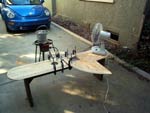
(click pictures to enlarge) |
Most recently, however, I finally
got up the courage to cast the lead sinkweights for the centerboard
and rudder. Between the inherent toxicity of the lead and the
additional hazard of heavy, molten metal, the task seemed a
bit daunting. I'm happy to report that I finished without injury
or apparent lead poisoning.
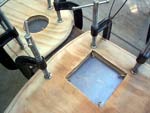
(click to enlarge) |
I took the standard safety procedures:
long pants, long sleeves, boots, gloves, and saftey glasses.
I also set up a fan blowing any fumes away from me. I put all
of the lead in to melt at once, so that any oils or moisture
would be driven off before the lead melted, avoiding splattering
molten lead with the addition of any water.
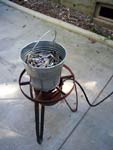 When
I cut out the plies for the rudder and centerboard, I went ahead
and cut out the openings for the lead weights. In doing so,
I set my jigsaw to cut at 45 degrees, so that when I laminated
the plies, the edges would form a pocket to hold the weight
in plaace. I also installed brass woodscrews protruding into
the opening to further lock the weight into place.
When
I cut out the plies for the rudder and centerboard, I went ahead
and cut out the openings for the lead weights. In doing so,
I set my jigsaw to cut at 45 degrees, so that when I laminated
the plies, the edges would form a pocket to hold the weight
in plaace. I also installed brass woodscrews protruding into
the opening to further lock the weight into place.
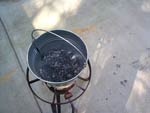 I
stopped by a local tire store this week and asked if they had
any used tire weights they'd sell me for a project. They said
that if they had any, I could have them for free, and I went
home with a 2.5 quart pail piled to the rim with weights.
I
stopped by a local tire store this week and asked if they had
any used tire weights they'd sell me for a project. They said
that if they had any, I could have them for free, and I went
home with a 2.5 quart pail piled to the rim with weights.
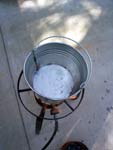 I
used a larger pail with a pour hole just bewlow the rim and
a baling-wire pouring handle twisted around the base for my
cauldron. I put it on top of a propane cooker, and after a few
minutes of smoking, the lead melted, leaving a layer of steel
clips and other dross floating on top, which was easily scraped
off. This proved to be much easier than washing all of the weights
to keep impurities out. Anything that didn't burn off floated
to the top, ready for removal.
I
used a larger pail with a pour hole just bewlow the rim and
a baling-wire pouring handle twisted around the base for my
cauldron. I put it on top of a propane cooker, and after a few
minutes of smoking, the lead melted, leaving a layer of steel
clips and other dross floating on top, which was easily scraped
off. This proved to be much easier than washing all of the weights
to keep impurities out. Anything that didn't burn off floated
to the top, ready for removal.
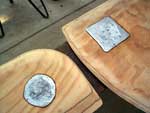 Once
the dross was removed, there was nothing left to do but pour
the lead and let it cool. It seems to have scorched the wood
a little bit, but it doesn't look like it will be a problem.
I over-poured a little bit, but It shouldn't be difficult to
scrape even with the surface.
Once
the dross was removed, there was nothing left to do but pour
the lead and let it cool. It seems to have scorched the wood
a little bit, but it doesn't look like it will be a problem.
I over-poured a little bit, but It shouldn't be difficult to
scrape even with the surface.
Next up: building blocks
and pintled & gudgeons.
Tidmarsh
Major
Tuscaloosa, Ala

